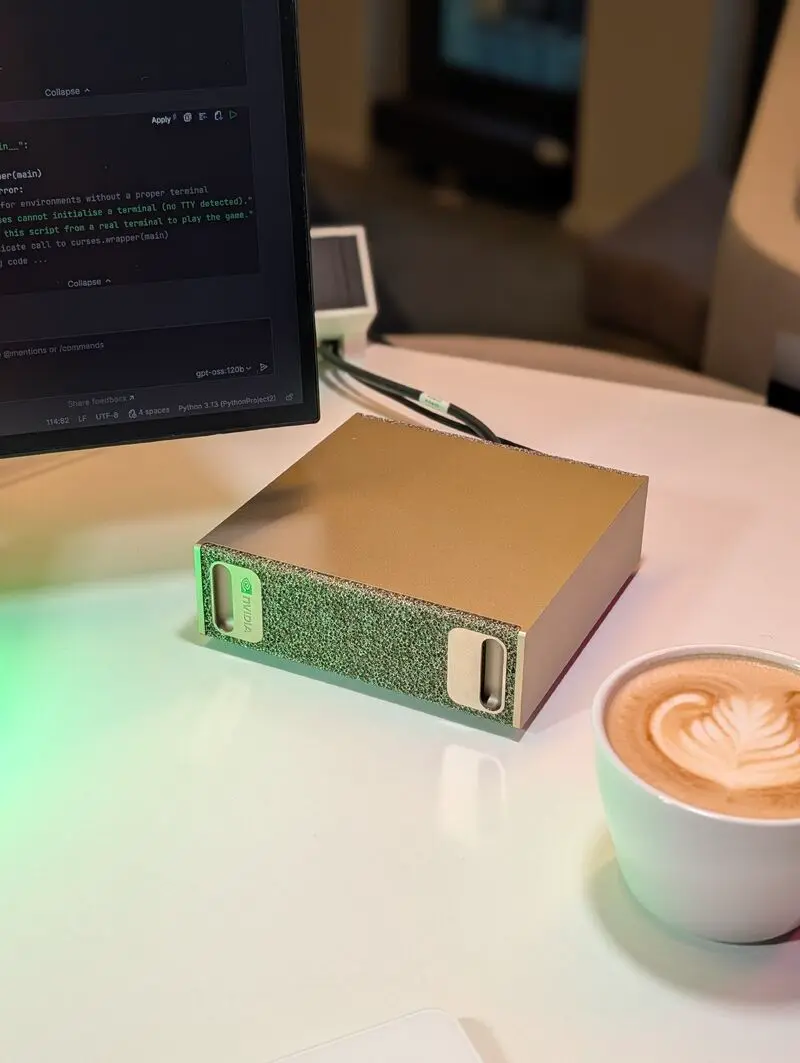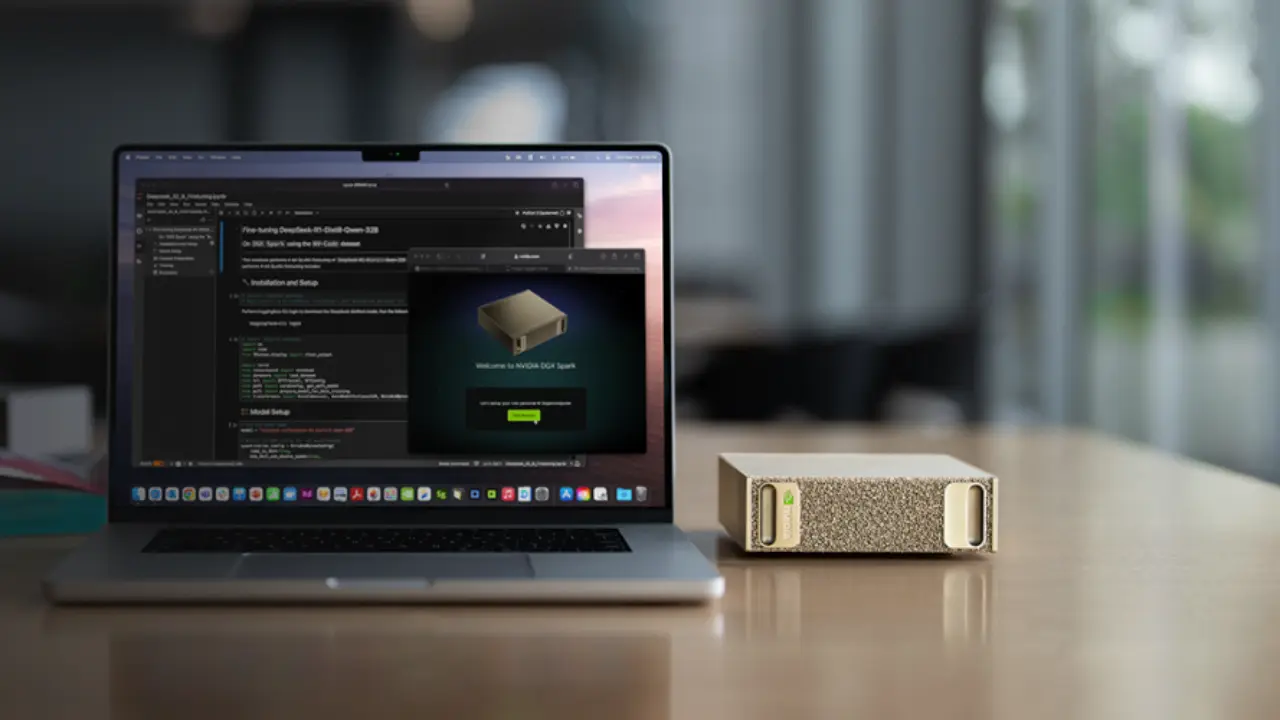
DGX Spark's Dirty Secret: NVIDIA's 1 PFLOPS AI Box Delivers Half That
Independent tests reveal NVIDIA's DGX Spark may only achieve 480 TFLOPS FP4 performance instead of the advertised 1 PFLOPS, with overheating issues compounding memory bandwidth limitations.
When NVIDIA CEO Jensen Huang personally delivered DGX Spark units to Elon Musk and Sam Altman, the message was clear: this was a watershed moment for AI development. The compact gold box promised to democratize AI supercomputing with its revolutionary specs - particularly the eye-catching “1 PFLOPS of FP4 AI performance” that dominated marketing materials.
But reality has a way of spoiling even the most carefully orchestrated launches. Independent tests from industry heavyweights like John Carmack (id Software founder) and Awni Hannun (Apple MLX lead) tell a different story: the DGX Spark might deliver barely half its advertised performance.
The Performance Gap That Nobody Expected
The numbers are stark: while NVIDIA claims “up to 1 petaflop of FP4 AI performance”, real-world tests show the device achieving just 480 TFLOPS of actual FP4 throughput - less than 50% of the advertised capability. The equivalent BF16 performance settles around 60 TFLOPS, putting it squarely in the mid-range GPU territory rather than revolutionary supercomputer class.

What makes these findings particularly damning is their source. Carmack brings legendary programming credentials from id Software and the iconic fast inverse square root algorithm, while Hannun leads Apple’s MLX framework development. When these technical titans independently verify performance shortcomings, the industry pays attention.
The performance deficit isn’t just theoretical - it manifests in practical benchmarks. Hardware reviewers found that building a DIY rig with three used NVIDIA 3090 GPUs delivers much higher token-generation throughput on large LLMs than the $3,999 Spark. The quad-3090 system achieved 124 tokens/second on GPT-OSS 120B models compared to the Spark’s 38.6 tokens/second - despite costing substantially less than NVIDIA’s premium offering.
The Memory Bandwidth Bottleneck Nobody Mentioned
The core issue appears to be a fundamental architectural limitation that NVIDIA’s marketing conveniently overlooked. The DGX Spark uses LPDDR5x memory with just 273GB/s of bandwidth - significantly less than the GDDR memory found in discrete gaming GPUs.
This memory bottleneck becomes painfully obvious in memory-bound workloads. While the Spark excels at compute-heavy tasks like prompt preprocessing (achieving 1,723 tokens/second on GPT-OSS 120B, slightly edging out the 3×3090 rig’s 1,642 tokens/second), it falls dramatically short during token generation where memory bandwidth becomes critical.

Even NVIDIA’s partner reviews acknowledge the bandwidth limitations. TWOWIN Technology’s analysis notes that “the use of LPDDR5X memory instead of the GDDR7 found in gaming GPUs results in significantly lower bandwidth (301GB/s), creating a performance bottleneck despite the large capacity.” This creates a fundamental mismatch: you have the memory capacity to load massive models (up to 200 billion parameters), but not the bandwidth to run them efficiently.
Real-World Benchmarks Tell the Tale
The performance discrepancies become undeniable when examining concrete benchmark results across multiple model sizes:

For the GPT-OSS 120B model, the Spark manages just 38.55 tokens/second in decode tasks compared to 124.03 tokens/second from the 3×3090 rig. AMD’s Strix Halo system - costing around $2,348 - achieves comparable performance at 34.13 tokens/second, raising serious questions about the Spark’s $3,999 price tag.
The pattern continues with smaller models. On Llama-3.1-8B inference, the Spark hits approximately 36 tokens/second while an RTX 5090 reaches 200 tokens/second - over 5x faster performance according to comparative testing. Even Apple’s M4 Pro chip in a Mac Mini achieves similar performance (34 tokens/second) for just $1,400 - about one-third of the Spark’s price.

Perhaps most embarrassing: an older AMD EPYC 7702 CPU system with no GPUs actually outperformed the DGX Spark in certain inference tasks. The EPYC system achieved 15.75 tokens/second on GPT-OSS 120B compared to the Spark’s 11.66 tokens/second - a stunning result that challenges the very premise of the Spark’s specialized AI acceleration.
Overheating and Thermal Throttling Concerns
The performance issues don’t stop at bandwidth limitations. Multiple sources report that “if you run it for an extended period, it will overheat and restart.” This thermal management problem suggests either inadequate cooling design or power delivery issues that prevent sustained peak performance.
The overheating problem compounds the bandwidth bottleneck. Even if firmware or software updates could theoretically unlock more performance, thermal constraints might prevent the DGX Spark from ever reaching its theoretical maximums. Users on developer forums report frustration with what they describe as “calculated product segmentation” - strategically limiting capabilities to protect NVIDIA’s higher-end product lines.
The Ecosystem Argument vs. Raw Performance
NVIDIA’s strongest counter-argument revolves around software ecosystem and unified memory advantages. The DGX Spark runs NVIDIA’s full AI stack natively, with CUDA, cuDNN, TensorRT, and other frameworks pre-installed and optimized for the GB10 Grace Blackwell Superchip.
Reviewers consistently praise the out-of-box experience. As Signal65 noted, “within a container on the Spark, ComfyUI spun up and we were generating images in minutes. The process was seamless, all the needed Docker containers and models were pulled automatically.” This plug-and-play experience represents significant value for enterprises prioritizing development efficiency over raw throughput.
The unified 128GB memory pool also enables workloads that are simply impossible on traditional GPUs. While discrete GPUs might offer higher performance on models that fit within their 24-48GB VRAM constraints, the Spark can handle models up to 200 billion parameters locally - a capability that previously required multi-GPU servers or cloud instances.
Competitive Landscape
The DGX Spark finds itself in an increasingly crowded market where alternatives offer better performance-per-dollar:
- AMD Strix Halo: At approximately $2,348 with 128GB RAM, it delivers comparable inference performance on many FP8/FP16 tasks
- 3x RTX 3090 DIY Rig: Using used components, offers significantly higher throughput for most workloads at similar or lower cost
- Apple M-Series: Provides competitive unified memory performance at substantially lower price points
- Traditional Workstations: Offer better general-purpose computing alongside GPU acceleration

The math becomes increasingly difficult to justify. As one Medium analysis bluntly put it: “When you’re training large models, memory bandwidth is what keeps the GPU fed with data. If that chokes, the fancy architecture doesn’t save you. You’ll hit bottlenecks long before you reach the theoretical ‘petaFLOP’ numbers NVIDIA advertises.”
What This Means for Buyers
For AI professionals considering the DGX Spark, the performance revelations create a complex decision matrix:
Consider the DGX Spark if:
- Your primary constraint is fitting extremely large models (>70B parameters) in memory
- You value NVIDIA’s ecosystem and out-of-box software experience
- Development time savings outweigh raw performance differences
- Budget constraints are secondary to workflow convenience
Look elsewhere if:
- Raw inference speed is your primary metric
- Your models fit within 24-48GB of VRAM
- Budget efficiency matters
- You need maximum performance-per-dollar
The prevailing sentiment among technical reviewers suggests that while the Spark represents an engineering achievement in miniaturization, its performance limitations and premium pricing make it difficult to recommend for most use cases. As PC Gamer summarized: “DGX Spark is way too expensive for the raw performance.”
Hardware Marketing vs. Reality
The DGX Spark controversy highlights a growing tension in AI hardware marketing. As manufacturers compete for attention with eye-catching performance numbers, the gap between theoretical peak performance and real-world delivered performance continues to widen.
NVIDIA’s 1 PFLOPS claim appears to represent a “sparse FP4” measurement under optimal conditions - a metric that bears little resemblance to actual workload performance. This mirrors similar marketing practices across the industry, where peak theoretical numbers often far exceed what users can realistically achieve.
The situation becomes particularly problematic when companies like AMD’s Strix Halo or Apple’s M-series chips deliver comparable real-world performance at significantly lower price points. When a CPU-only system can match or exceed specialized AI hardware on certain benchmarks, it raises fundamental questions about product positioning and value proposition.
Revolutionary Concept, Compromised Execution
The DGX Spark represents both NVIDIA’s ambitious vision for democratized AI computing and the practical compromises inherent in that vision. While the concept of a desktop AI supercomputer is compelling, the execution reveals significant performance gaps between marketing claims and real-world delivery.
For enterprises and researchers who need to prototype massive models locally, the Spark’s 128GB unified memory provides unique capabilities that justify its premium. But for most developers and organizations, alternatives offer better performance, better value, or both.
The independent verification of performance gaps by respected figures like Carmack and Hannun underscores an important reality: in the rapidly evolving AI hardware landscape, buyers need to look beyond marketing claims and examine real benchmark data. The DGX Spark may deliver NVIDIA’s ecosystem and convenience, but it comes with performance compromises that make its value proposition far more nuanced than the 1 PFLOPS sticker might suggest.
As the industry digests these findings, pressure will mount on NVIDIA to either improve performance through software updates, adjust pricing, or provide clearer explanations of exactly what their performance claims represent. Until then, buyers would be wise to test thoroughly before committing to what might be an expensive lesson in the difference between theoretical and actual performance.



